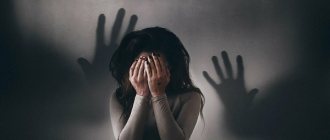Phonophobia – fear of loud sounds,
this phobia also has other names -
acousticophobia and ligyrophobia , which are synonyms.
They mean slightly different things. Phonophobia is the fear of sounds in the broadest concept, acousticophobia is the fear of certain sounds, for example, the human voice, including one’s own, and ligirophobia is the fear of loud sounds, and also of the devices that produce them (for example, working machines, engines, loud-sounding acoustic systems, alarms, alarm clocks). Fear can seize phonophobes already at the origin of a sound or even when expecting it, for example, while listening to a CD, when some time passes before the start of playback, and then the playback of the track suddenly begins.
In order not to experience severe discomfort again, phonophobes try to avoid places and events where it is crowded and noisy, for example, they never visit:
- sporting events;
- concerts of musical groups;
- large shopping centers;
- parks;
- bars,
- other establishments and places where there are plenty of sources of loud sounds.
Phonophobes may not travel in public transport, not use an airplane, or refuse a profitable and promising job if it is associated with chronic noise. They also tend not to interact with people with loud voices, babies who may suddenly scream, and animals, mainly dogs, because they can scare them by barking.
Some people with a particularly strong fear of loud noises may limit their contact with the world as much as possible and almost never leave the house, where they can control all the sounds around them. Naturally, this is not a solution to the problem and you cannot live like that. Phonophobia, like other phobias, can be dealt with through treatment, the main method of which today is psychotherapy.
Causes of fear
Events influence the human psyche. Participants in military operations came under fire. In peaceful life, they remain afraid of sharp sounds. The child hears his parents screaming during quarrels. He grows up, but the fear of sharp or loud sounds remains. This fear arises for the following reasons:
- Tragedies of the past. Fear of loud sounds occurs among witnesses or participants in car accidents, train accidents, or terrorist attacks.
- Natural disasters. Natural phenomena such as thunderstorms and tornadoes cause panic. People are hiding in their homes. Hearing thunder is unbearable for them.
- Horror films. They are for people with strong nerves. Don't get carried away by horror if you flinch at unexpected sounds and hide under the covers when monsters and monsters appear on the screen.
The child is frightened by electrical appliances. They make noise, buzz, whistle, rumble. A child may have a tantrum when turning on a vacuum cleaner or hair dryer.
Fear of external noises
It is natural for a person to be afraid of loud sounds, to shudder and look back in the direction of the noise. This is a defensive reaction to exposure to a sharp external noisy stimulus. The reflex is developed from birth: a newly born baby reacts to external noise by spreading its legs and arms in different directions. Fear of noises is normal unless it becomes an uncontrollable phobia.
It is also called ligyrophobia and acousticophobia. Sometimes these terms are used as synonyms, although there are inconsistencies. Literally translated, phonophobia is the fear of loud sounds. Acousticophobia is auditory-coordinated fear. Ligyrophobia is the fear of extraneous noises and devices that produce them.
Humans react to loud noises from birth
Symptoms
People who are afraid of sharp sounds experience the following symptoms:
- cardiopalmus;
- increased sweating;
- dry mouth;
- pale skin;
- increased blood pressure;
- dilated pupils;
- trembling of hands and feet;
- numbness of fingers;
- dizziness;
- muscle tension;
- loss of self-control.
In severe cases of the disease, panic attack syndrome may develop. It will lead to a serious mental disorder - neurosis. Treatment is long-term, over several years.
Increased blood pressure accompanies a fear attack
Hypersthenic stage
This is the initial stage of the disease. Symptoms of neurasthenia at this stage are expressed in increased mental excitability and a pronounced nervous reaction. Anything can cause irritation: from simple noise to crowds of people. Very quickly, patients lose their state of nervous and mental balance, shout at others, and lose self-control. At this stage, a person experiences problems with concentration, they are unable to concentrate on anything, are distracted and complain of poor memory. Headaches, a feeling of heaviness in the head, and pressure in the temples are also common.
What are phonophobes afraid of?
People have specific objects and events that frighten them. These include:
- Balloons. A person is afraid to be near inflated balloons. At the mere thought that the balloon might burst and make a loud sound, the phonophobe's palms sweat and knees tremble. Inflating the balloon yourself is out of the question.
- Musical toys. Children cry if the sound of a toy frightens them. It may be a cheerful tune, but it is too loud for a baby. A child may have fear for the rest of his life.
- Loud voice. Phonophobe does not like airports and train stations. He is afraid to imagine that he will hear the loud voice of the dispatcher. A person does not go to public places where it is always noisy.
- Bird sounds. People can't stand it when flocks of crows circle overhead. This chorus of ominous croaks is associated with aggression. The next step is an attack. These birds are considered residents of the cemetery. Meeting them makes you think about death.
- Pyrotechnics. On New Year's Eve or Victory Day, the phonophobe will stay at home. He has already soundproofed the apartment so as not to hear frightening sounds.
It is impossible to predict what will trigger a panic attack.
Sitting at home or hiding from sounds every time is not an option. This way you will miss a lot of interesting things in life.
Phonophobe fears balloons that burst with a loud sound
What is neurasthenia? Description
Neurasthenia implies severe depletion of the nervous system , which is clinically accompanied by a number of specific symptoms. The leading symptoms of asthenic syndrome are a decrease in endurance to physical and mental stress, rapid fatigue from habitual activity, increased irritability, instability and rapid mood swings. Neurasthenia manifests itself with unpleasant somatic and neurological symptoms: cephalalgia, muscle pain of a psychogenic nature, autonomic dysfunction, and disruptions in sleep-wakefulness.
Neurasthenia is based on a breakdown of higher nervous activity, which is a reversible phenomenon regardless of the intensity and duration of the symptoms demonstrated. Neurasthenia differs from psychoses in the complete absence of psychotic syndrome: manifestations of personality disorders do not reach the level at which a critical attitude towards one’s condition is lost and the individual’s adaptation to society is disrupted. This disorder occurs without any signs of psychosis and the person is fully aware of his illness. Neurasthenia is subjectively perceived by a person as a severe pathology. This asthenic disorder can significantly worsen the quality of life of an individual.
Unlike psychopathy and psychosis, neurasthenia occurs after a real psychotraumatic situation, which is combined with excessive overload of the body and a lack of physiological amenities, for example: regular lack of sleep. The development of asthenic syndrome is facilitated by viral and bacterial infections, chronic intoxication of the body and other painful conditions of organs and systems.
Asthenic neurosis is determined with equal frequency in representatives of both sexes, while the overwhelming number of patients are mature people of working age over 25 years old. In women, the symptoms of neurasthenia are much more severe; in them, this disorder is often aggravated by more serious pathologies. In the last decade, neurasthenia has often been recorded in children and adolescents who are overly busy with educational activities, extracurricular sports or intellectual activity.
Most of the people who have been diagnosed with “neurasthenia” are residents of large cities. However, to say that asthenic neurosis is the result of a busy life in industrial centers is not entirely fair, since until now the mentality of village residents is accustomed to attributing the symptoms of asthenic disorders to banal passing fatigue. In addition, not every village hospital has a vacancy for a neurologist and psychiatrist who can carry out competent diagnostic measures and differentiate this type of neurosis from other painful conditions.
Treatment of fear
The psychotherapist will make a diagnosis and prescribe treatment:
- Tranquilizers: phenazepam, midazolam, buspirone. Help relieve anxiety and fear.
- Psychotropic drugs: deloxetine, venlafaxine, milnacipran. Prescribed for depression.
- Sedatives: novo-passit, nozepam, barboval. They have a sedative effect.
You can treat fear using unconventional methods:
- Neurolinguistic programming. Modeling verbal and nonverbal behavior produces results. Opponents of neurolinguistic programming talk about the danger of restructuring the psyche.
- Hypnosis. Patients are wary of this method. In a state of trance, they can tell something that an outsider does not need to know. Those who decide to undergo hypnosis will feel improvement after the first sessions.
- Sound therapy is the use of contrasting melodies. First, the patient listens to a calm melody, then a loud one. And such a change of compositions occurs several times during the session.
A person who experiences fear is constantly tense. He expects to hear a loud sound at any moment and will not be able to control his emotions. A doctor can help you cope with this condition.
Neurasthenia: how to overcome a state of neuropsychic weakness?
A separate group of non-psychotic level disorders includes pathological conditions with not pronounced changes in the mental sphere - neuroses . All disorders of this group can be described as debilitating neuropsychic weakness, the development and course of which, as well as methods of compensation, are determined by the action of psychogenic factors.
There are various divisions of neuroses into separate types. The most common type of neurotic disorder is neurasthenia , also called asthenoneurotic syndrome or asthenic neurosis. In some sources, neurasthenia, due to the similarity of symptoms, is equated to chronic fatigue syndrome, although according to the latest scientific research, these two psychogenic conditions have completely different pathogenesis and require different treatment.
Forms of neurasthenia
In clinical practice, neurotic disorders are conventionally divided into three separate forms:
- hypersthenic (excitable);
- irritable weakness;
- hyposthenic (inhibitory).
All these forms reflect the severity of neurasthenia, being specific stages of this disorder. Since asthenic neurosis is characterized by a gradual increase in the intensity of symptoms, that is, aggravation of the pathology, the above forms convey the sequence of phases of the disease. However, in many patients the painful condition is fixed in one specific form: at the first or second stage, that is, there is virtually no negative dynamics. For this reason, the diagnosis is often formulated as follows: hypersthenic or hyposthenic neurasthenia, asthenic neurosis in the form of irritable weakness.
Diagnostics
It is not difficult to distinguish neurasthenia from other pathological disorders. An experienced doctor is able to quickly differentiate asthenic disorder from other pathological mental states. The main task is to exclude any organic lesions of the central nervous system and oncological pathologies accompanied by asthenic syndrome.
In the treatment of neurasthenia, the leading role is played by measures aimed at eliminating or at least minimizing negatively influencing factors. The main emphasis in treatment is on preventing overload, optimizing the work and rest schedule, and ensuring a good night's rest.
During a conversation with the patient, the doctor explains to the patient the features of his condition and points out the conditions the creation of which is necessary to normalize his mental state. Psychotherapeutic work is also aimed at teaching a person constructive forms of coping with stress and motivating the patient to make radical changes in his lifestyle. The doctor’s goal: to explain that the symptoms of neurasthenia are not a death sentence, but surmountable circumstances when harmful factors are excluded. The doctor’s task is, together with the patient, to identify negative circumstances and take constructive measures to overcome their impact. Recommended measures to treat the disorder include:
Of particular importance for getting rid of neurasthenia is teaching the patient relaxation skills: autogenic training, self-hypnosis, techniques for relieving emotional stress. Among general restorative measures: physiotherapeutic procedures, massage, electrosleep.
The basis of drug treatment: natural adaptogens, stimulants, vitamin and mineral complexes. A patient with neurasthenia must be prescribed B vitamins and magnesium supplements.
Among sedatives, preference is given to drugs of plant origin, for example: Persen. As a general tonic in the treatment of neurasthenia, agents that improve tissue metabolism are used, for example: calcium glycerophosphate (Calciiglycerophosphas). Among medications with a tonic effect, it is advisable to use a stimulant of the central nervous system - pantocrine (Pantocrinum).
For hypersthenic neurasthenia, muscle relaxanthelenium (Elenium) is often used in treatment. The hyposthenic form of neurosis often requires the use of tranquilizers, for example: Rudotel. For any form of neurasthenia, the antipsychotic thioridazine can be used in treatment, however, taking this antipsychotic requires a careful study of the patient's medical history due to a wide range of side effects.
The prognosis of neurasthenia with a correctly selected treatment regimen and the patient’s compliance with all medical measures is favorable. However, there is always a risk of relapse of neurosis, so preventive and restorative measures are of particular importance.
SUBSCRIBE TO THE VKontakte GROUP dedicated to anxiety disorders: phobias, fears, obsessive thoughts, VSD, neurosis.
fobiya.info











